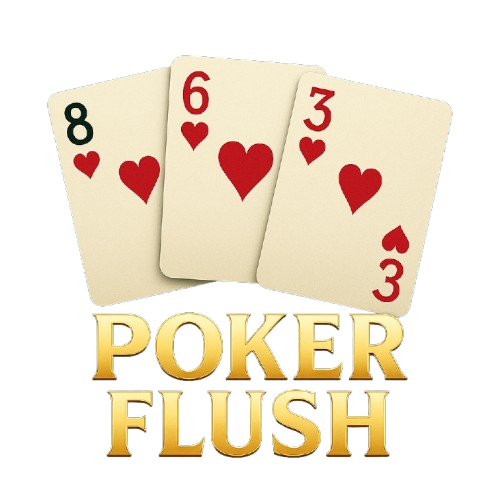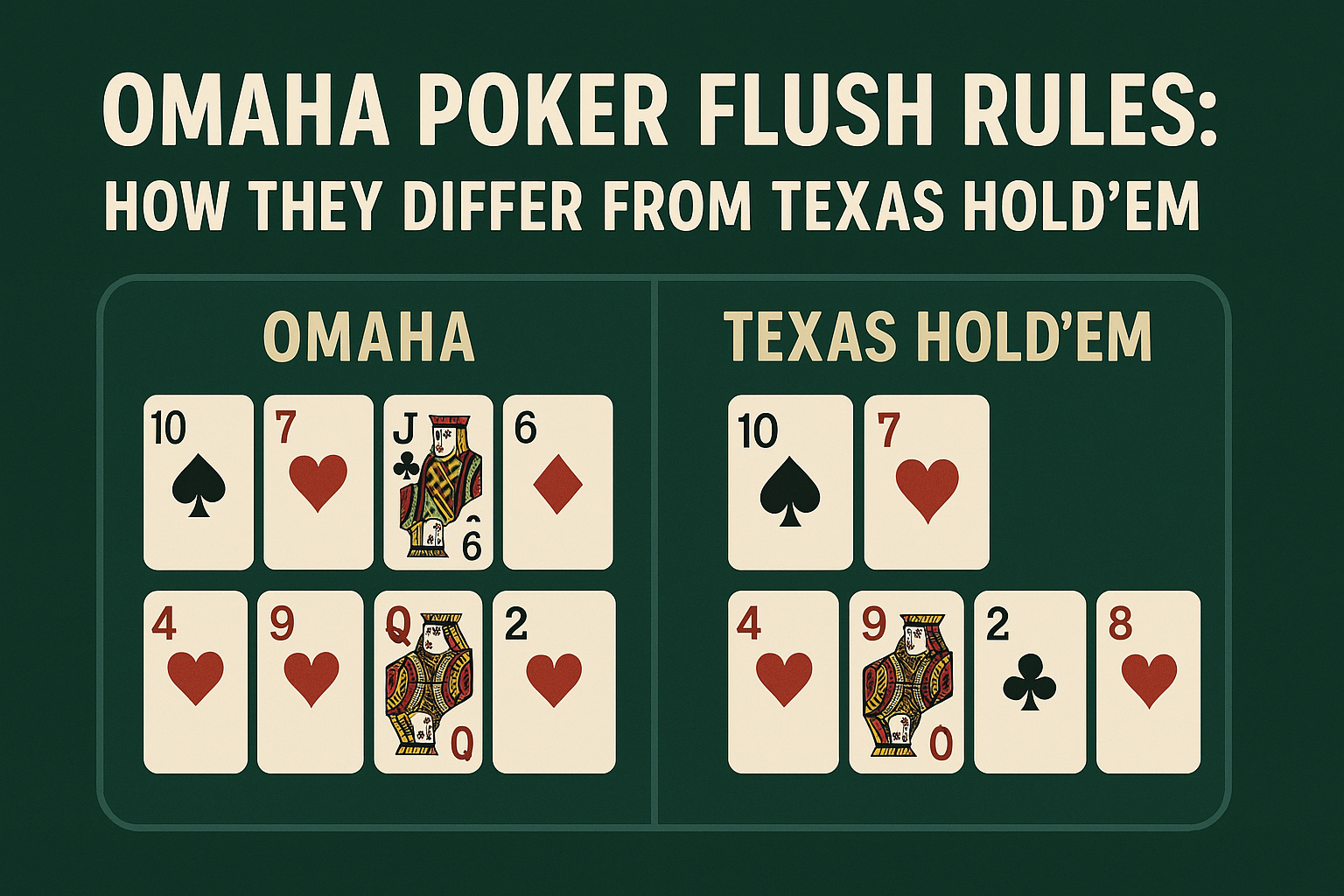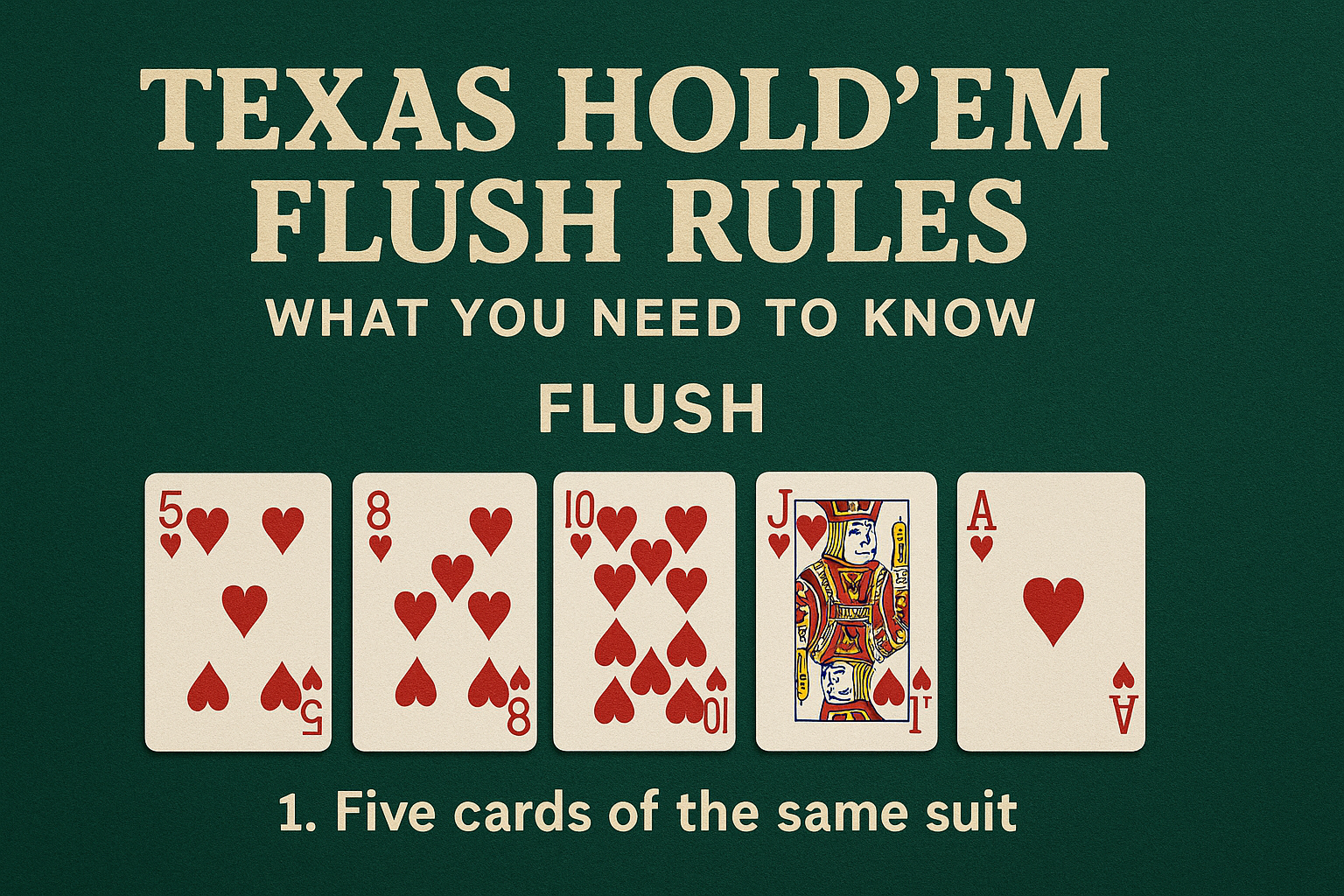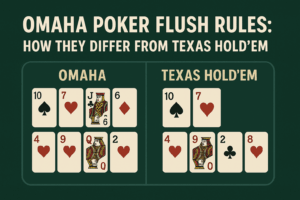In the world of poker, the flush is a fundamental and powerful hand. A flush consists of five cards of the same suit, and it can win or lose depending on its strength compared to other players’ flushes. However, the rules that govern flushes vary slightly between different variants of poker, and one of the most significant differences is between Omaha and Texas Hold’em. To play these games with confidence, it’s essential to understand the specific poker flush rules that apply in each format.
While many players are familiar with flush hands in Texas Hold’em, Omaha poker adds a layer of complexity due to the number of hole cards and the requirements for hand construction. Misunderstanding these rules can lead to costly mistakes, especially in flush versus flush scenarios. This guide will walk you through the omaha poker flush rules and how they differ from the more familiar Texas Hold’em rules.
The Basics of Omaha Poker and Hand Construction
Omaha is a community card game similar to Texas Hold’em but with one key difference: each player receives four hole cards instead of two. The goal remains the same—make the best five-card hand using a combination of your hole cards and the community cards. However, Omaha requires players to use exactly **two** of their four hole cards and **three** of the five community cards to construct a hand.
This mandatory combination is the heart of many rule misunderstandings, especially when it comes to creating flushes. In contrast to Texas Hold’em, where players can use any combination of hole and community cards, Omaha strictly enforces the two-from-hand, three-from-board rule.
Omaha Poker Flush Rules Explained
In Omaha, a flush is made by combining **exactly two** suited cards from your hand with **three** suited cards from the community cards. If a player fails to use two suited cards from their hand, they do not have a flush, even if there are five suited cards among the community cards.
For example, suppose the board has K♣, 9♣, 7♣, 3♦, 2♠, and your hole cards are A♣, Q♣, 5♦, and 8♥. You have two clubs in hand and can use them with the three clubs on the board to make an ace-high flush. In contrast, if you held only one club in your hole cards, you would not qualify for a flush under omaha poker flush rules, even though five clubs are visible between your hand and the board.
This strict requirement often catches new Omaha players off guard. Holding just one club in the hand, even if the board is full of clubs, is not enough. This is one of the most important distinctions from Texas Hold’em, where using one or even no suited cards from your hand can still result in a flush if the board supports it.
Texas Hold’em Flush Rules Recap for Comparison
In Texas Hold’em, each player is dealt two hole cards, and they can use any combination of hole cards and community cards to make their best five-card hand. This means a player can make a flush even if only one of their hole cards matches the suit of the community cards.
For example, if the board shows four hearts and a player has just one heart in their hole cards, they can still make a flush. The flexibility in Texas Hold’em allows more players to qualify for flushes in the same hand, leading to frequent tie-breakers and high card comparisons.
This freedom is not present in Omaha, which makes omaha poker flush rules more demanding and strategic. Players must pay close attention to the suits in their starting hand and how those match with the community cards.
Flush Strength and Ties in Omaha Poker
Just like in other poker variants, when two or more players complete a flush in Omaha, the winner is determined by the highest card in the flush. If two players have the same high card, the second-highest card is considered, and so on. If both players use the same five cards to make a flush, the hand is tied and the pot is split.
This tie scenario typically only happens when both players are using the exact same suited cards from the board, along with matching suited cards in hand. However, due to the two-card rule in Omaha, this type of tie is less frequent than in Texas Hold’em. It’s rare for two players to have the exact same two suited cards in hand that match the community cards perfectly.
Understanding how poker flush rules apply during a tie is crucial for Omaha strategy. Players should always consider not only whether they can make a flush but whether it is likely to be the **best** flush. A lower flush in Omaha can easily be dominated by an opponent who has higher suited cards, especially in multi-way pots.
Common Mistakes Players Make with Omaha Flushes
Many players who transition from Texas Hold’em to Omaha make the mistake of misreading their hand strength. Seeing a suited board and holding one card of that suit might feel like a winning hand, but in Omaha, that is never enough. Another common error is overvaluing flush draws with only one suited hole card, leading to calls or bets that have no chance of completing a legal flush.
Players also frequently ignore the potential for higher flushes. Because Omaha deals four hole cards, the probability that someone else holds two suited cards that can beat your hand is higher. Betting aggressively with a weak flush can lead to major losses.
Learning to correctly read the board and understand the suit combinations is essential. Before betting or calling with a flush, verify that you’re meeting the requirement of using two hole cards and ask yourself if stronger flushes are possible based on the revealed cards.
Flush Draw Strategy in Omaha
Flush draws in Omaha can be powerful, especially when they are accompanied by other draws like straights or full houses. Because players hold four cards, the potential to hit multiple draws is high. When drawing to a flush in Omaha, players must calculate their outs carefully and understand which cards actually improve their hand under the two-card rule.
For example, if you have two diamonds in hand and the flop comes with two more diamonds, you have a four-to-a-flush situation. You need one more diamond to complete the flush, but it has to be a card that allows you to still use two diamonds from your hand and three from the board. This nuance often makes Omaha draws trickier than in Hold’em.
Aggressive play with a strong flush draw can pay off, particularly if your hand also has backup potential, like top pair or straight outs. However, cautious evaluation of your opponents’ possible holdings is equally important. Because everyone has more cards, the likelihood that someone else is on a similar or better draw increases.
Board Texture and Flush Potential
Understanding board texture is vital when it comes to omaha poker flush rules. A board that shows three suited cards is often dangerous, especially in multi-way pots. If you have the nut flush draw, you may be in a strong position, but anything less demands careful play.
The difference between a dry board (with fewer suited cards) and a wet board (with heavy flush and straight potential) becomes even more pronounced in Omaha. A wet board requires players to be defensive and prepared for fast action, while a dry board allows more controlled betting and value extraction from weaker hands.
On boards that present obvious flush opportunities, the betting can escalate quickly. In these moments, knowing that your flush is the nut flush—or not—can be the deciding factor in whether you continue in the hand.
How the Nut Flush Is Critical in Omaha
The “nut flush” in Omaha refers to the highest possible flush based on the board and the cards in your hand. This is typically a flush that uses the ace of the suited cards, ensuring that no other flush can beat it. Because players must use two hole cards, you must have both the ace and another suited card in your hand to qualify for the nut flush.
Failing to recognize whether you hold the nut flush—or a vulnerable one—can lead to strategic blunders. Betting big with the second or third-best flush might seem correct, but if your opponent is experienced and shows strength, it often means you are beat.
In Omaha, being disciplined and waiting for the nut flush or avoiding marginal flushes altogether can preserve your bankroll and reduce variance.
Comparing Flush Frequency in Omaha vs Hold’em
One interesting aspect of comparing Omaha and Hold’em is the frequency with which players hit flushes. Because Omaha offers four hole cards, the chances of being dealt suited combinations are higher. As a result, flushes are more common in Omaha, and the competition for high flushes is tougher.
In Hold’em, a player may hit a flush and feel confident that it is likely to be the best hand. In Omaha, however, more players will make flushes during a hand, and the strength of those flushes will often be very close. This dynamic raises the importance of knowing your opponents and understanding betting patterns to anticipate whether your flush is good enough to win.
Conclusion: Mastering Omaha Poker Flush Rules
Mastering omaha poker flush rules is one of the first steps toward becoming a successful Omaha player. The difference from Texas Hold’em is significant: you must always use exactly two cards from your hand and three from the board to make a valid flush. This rule changes how flushes are built, evaluated, and played.
Players who come from a Texas Hold’em background must adapt their mindset and hand-reading skills. Relying on Hold’em instincts in Omaha can result in misplayed hands and incorrect assumptions about flush strength. Whether you are completing a flush, drawing to one, or facing an opponent who might have it, understanding the true rules of hand construction is essential.
If you’d like to explore a detailed comparison of Omaha and Hold’em strategies, check out this poker variant breakdown for more insights.
By focusing on the nuances of hand construction, reading board texture, and respecting the strength of opposing hands, you can make more informed decisions at the table and avoid the common pitfalls that come with misplaying flushes in Omaha.






